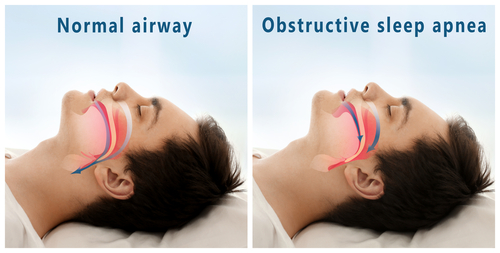What is dental sleep apnea treatment, and how does it work?
Dental sleep apnea treatment involves dental appliances, such as oral splints or mandibular advancement devices, to help treat sleep apnea. These devices work by repositioning the jaw and tongue to keep the airway open during sleep, reducing or eliminating apnea episodes, and improving breathing.
Sleep apnea is a sleep disorder that affects millions of people worldwide. Traditional sleep apnea treatments include continuous positive airway pressure machines, surgery, and lifestyle changes. However, these ineffective treatments can be uncomfortable or inconvenient for patients. Dental appliances have emerged as a viable solution to treat sleep apnea and improve sleep quality. In this blog, we will dive into the principle behind dental appliances for sleep apnea, the types of dental appliances available in the market, their pros and cons, potential risks to consider, and how effective they are compared to traditional treatments. We will also discuss how to converse with your doctor about using dental appliances to treat sleep apnea.
The Common Challenges with Traditional Sleep Apnea Treatments
The adverse effects of standard sleep apnea treatments can significantly impact overall health, leading to potential therapy non-compliance. Some patients may struggle with the discomfort of continuous positive airway pressure therapy, necessitating further adjustments for therapy adherence. Moreover, traditional treatments such as oral appliances or CPAP machines may not be suitable for all individuals with sleep apnea, highlighting the need for alternative solutions. Additionally, the side effects of continuous positive airway pressure therapy and other standard treatments can exacerbate underlying health problems, making effective treatment challenging.
The Emergence of Dental Appliances as a Solution
Offering an effective alternative for managing obstructive sleep apnea, dental appliances have gained recognition in recent years. This non-invasive treatment option has shown positive results in treating sleep apnea. The role of qualified dentists is crucial in diagnosing and treating sleep apnea using dental appliances, emphasizing the importance of expertise in this emerging field. With the increasing recognition of dental appliances, patients now have more options for managing sleep apnea beyond traditional treatments, addressing the need for alternative and practical solutions.
The Principle behind Dental Appliances for Sleep Apnea
Repositioning the lower jaw during sleep improves upper airway patency, preventing obstruction. By stabilizing the tongue’s position, dental appliances reduce airway blockage. These devices modify the soft tissue position, decreasing airway collapse and maintaining patency. The forward position of dental appliances effectively alleviates sleep apnea symptoms. Mandibular repositioning and tongue-stabilizing devices are crucial in addressing obstructive sleep apnea. These NLP terms enhance the content: CPAP therapy, heart rate, moderate OSA, oral device, central sleep apnea, rapid maxillary expansion, diagnosis of OSA, loud snoring, and structural abnormalities.
Mandibular Advancement Devices and Their Role
Mandibular advancement devices play a crucial role in treating obstructive sleep apnea by repositioning the lower jaw during sleep, thereby preventing airway collapse. By maintaining upper airway patency, these oral appliances effectively improve breathing and assist in airway expansion through adjustments to the position of the lower teeth. Additionally, mandibular advancement devices offer a comfortable alternative to continuous positive airway pressure therapy, relieving patients who may not tolerate CPAP machines. These devices form an integral part of the standard treatment for sleep disorders, addressing a host of health problems associated with untreated sleep apnea, such as high blood pressure, heart failure, and structural abnormalities.
Tongue-Stabilizing Devices and their advantages
Tongue-stabilizing devices play a crucial role in preventing airway obstruction during sleep by keeping the tongue forward. These oral appliances effectively stabilize the tongue’s position, maintaining airway patency to reduce sleep apnea symptoms. Their advantages lie in their simplicity, comfort, and effective airway management, offering a non-invasive alternative to standard sleep apnea treatments. By utilizing tongue-stabilizing devices, individuals can experience improved sleep quality and reduced health problems associated with untreated sleep disorders. The American Academy of Dental Sleep Medicine supports the effectiveness of these devices, making them a valuable option for those seeking relief from sleep apnea symptoms.
Potential Risks and Downsides to Consider
When considering dental appliances for sleep apnea treatment, it’s essential to be aware of potential adverse effects. Patients should evaluate the risks of jaw discomfort, teeth misalignment, and the possibility of mouth dryness. Consulting with sleep specialists can help assess the impact on dental health, including oral hygiene. It’s crucial to weigh the benefits against these drawbacks when deciding about sleep apnea treatments. Additionally, discussing potential side effects with qualified sleep physicians is essential for informed decision-making. Considering these factors will aid in making an informed choice for sleep apnea treatment.
How Effective Are Dental Appliances in Treating Sleep Apnea?
Dental appliances offer an effective solution for treating obstructive sleep apnea (OSA). These devices keep the airway open during sleep by repositioning the lower jaw. This treatment is especially recommended for patients with moderate to severe OSA, improving their quality of life and reducing daytime sleepiness. Qualified dentists and sleep specialists trust dental appliances.
Conclusion
In conclusion, dental appliances have emerged as a viable solution for treating sleep apnea, offering an alternative to traditional treatments. These appliances work by repositioning the jaw or stabilizing the tongue, allowing for improved airflow during sleep. While they may have pros and cons, dental appliances effectively treat sleep apnea for many individuals. It is essential to have open and honest conversations with your doctor about these options, discussing any potential risks and evaluating their effectiveness for your specific case. If you are struggling with sleep apnea, don’t hesitate to reach out to your healthcare provider to explore the possibility of using dental appliances as part of your treatment plan.
Make an appointment by calling (937) 446-6781.

 Meet Dr. Botti
Meet Dr. Botti
 Meet Dr. Scranton
Meet Dr. Scranton
 Our Team
Our Team
 Patient Forms
Patient Forms Online Bill Pay
Online Bill Pay Benefit Program
Benefit Program Your First Visit
Your First Visit